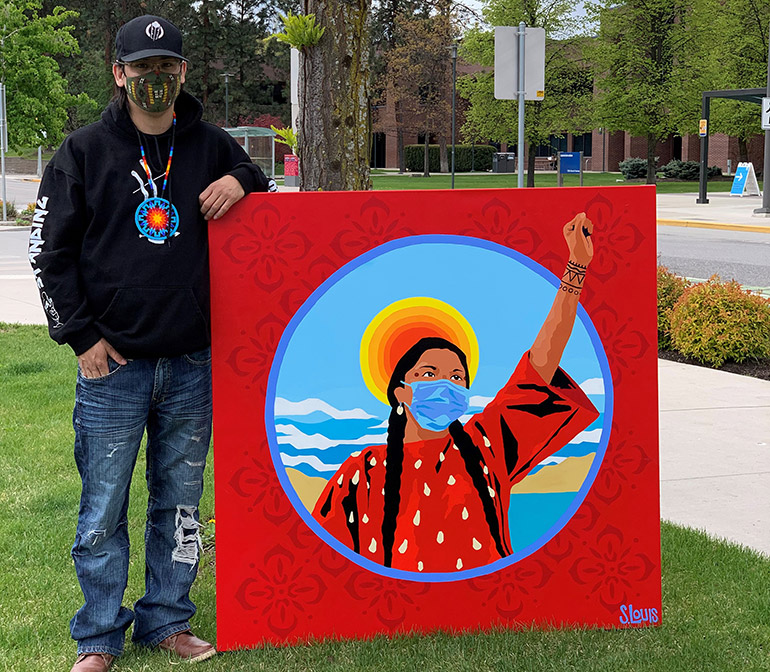
cax̌alqs – red dress — 4’ x4’ acrylic on canvas
Syilx artist Sheldon Pierre Louis creates painting to represent unwavering strength
A new painting titled cax̌alqs — red dress by Syilx artist Sheldon Pierre Louis has been added to UBC Okanagan’s Public Art Collection. The painting depicts an Indigenous woman wearing a red dress and a face mask.
The Okanagan School of Education worked with Dr. Stacey Koosel, UBC Okanagan art gallery curator with the Faculty of Creative and Critical Studies, to commission the new addition.
“We are excited to add this new work to our collection, as Sheldon Pierre Louis is an important Syilx artist with tremendous talent, bravery and influence,” says Koosel. “This is the first work of his that we have the honour of adding to our public art collection.”
The painting is located in Tower One on the third floor of the Engineering, Management and Education building on campus.
“It is particularly important for the Okanagan School of Education community to recognize the significance of Indigenous histories, cultures, knowledges, and identities, reflected in the learning environment,” says Dr. Margaret Macintyre Latta, director of the Okanagan School of Education. “As the School is situated on the unceded and traditional territory of Syilx Okanagan Nation, the installation of Sheldon Pierre Louis’ painting significantly offers a cultural-visual-artistic expression by a Syilx artist. The painting marks an important opportunity for the school, campus and greater community, seeking together a new relationship between Indigenous and non-Indigenous peoples and the land; one based in honour and respect.”
Sheldon Pierre Louis wants to take the opportunity to use his platform as a vessel for change. Art, he says, can be an educational tool, a conversational opening as well as a political weapon.
“As a Syilx artist I have always sought to use my art as a catalyst for discussion, to create spaces where uncomfortable issues can be brought forward into the societal dialogue to be given a voice,” he adds.
This particular piece of work has many levels, he explains. The canvas highlights the current times, as the mask represents the pandemic, and in some cases has been seen as a symbol of the “oppression” society is experiencing. But Sheldon Pierre Louis says the viewer will see the Indigenous woman wearing a mask and standing strong. In her stance, she shows the mask in this instance does not hinder her strength or resolve. The elk teeth on the red dress are a symbol of her deeply rooted and celebrated importance and worth in Indigenous society. The red dress is a symbol for the Missing and Murdered Indigenous Women, Girls, and Two-Spirit (MMIWG2S) Movement.
“By placing this image out into the public area of the campus it gives voice, and hopefully a sense, that the issues and concerns and spirits of our women will not be silenced and will not go unnoticed,” he adds.
With a focus on Canadian contemporary art and the Okanagan’s emerging local artists, UBC Okanagan’s Public Art Collection holds one of the largest collections in the region, says Koosel. UBC Okanagan is working towards building an art collection that is inclusive and celebrates Indigenous art and culture, she adds. The acquisitions policy of the Public Art Collection was recently updated to prioritize commissions by local Indigenous artists.
Sheldon Pierre Louis will host an artist talk online on Tuesday, June 22 at 7 p.m. He will talk about his art practice and the new commission and a Q&A session will follow. Register for the talk at: events.ok.ubc.ca/event/sheldon-pierre-louis-artist-talk
For more information about the piece, visit: gallery.ok.ubc.ca/public-art-collection
About UBC’s Okanagan campus
UBC’s Okanagan campus is an innovative hub for research and learning founded in 2005 in partnership with local Indigenous peoples, the Syilx Okanagan Nation, in whose territory the campus resides. As part of UBC—ranked among the world’s top 20 public universities—the Okanagan campus combines a globally recognized UBC education with a tight-knit and entrepreneurial community that welcomes students and faculty from around the world in British Columbia’s stunning Okanagan Valley.
To find out more, visit: ok.ubc.ca